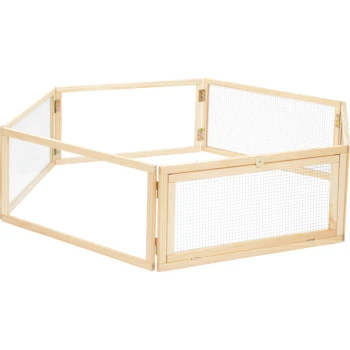Outdoor enclosures for small animals
Open-air enclosures & outdoor enclosures for small animals in the online Maxi Zoo shop
Open-air enclosures and outdoor enclosures for a natural small animal environment
Rolling in green grass, enjoying the sunshine or digging – open-air enclosures and outdoor enclosures offer small animals like rabbits, hares, guinea pigs and the like a natural lifestyle. However, there are a few things which you should bear in mind when using an enclosure.
What is the ideal location for an open-air enclosure?
Choose the location of an external enclosure carefully. Bright sunlight should not shine into the enclosure and the area should be free of draughts. Rabbit & guinea pigs require a lot of free space to let off steam. For this reason, you should allow for at least two to three square meters of free running space per small animal. The enclosure should also have sufficient shaded places, as the animals are very sensitive to heat. A sunroof which covers two-thirds of the open-air enclosure protects not only against sunlight, but also against rain. In addition to being protected against the elements, your small animals will also need to be protected against uninvited guests such as martens, foxes, cats and birds of prey. You will be able to keep these predators at bay with small-mesh and robust chicken wire which you can stretch over and around the enclosure. Dig the wire at least 50 centimetres into the ground. In this way, predators will not be able to dig a tunnel into the open-air enclosure and the residents will not have escape route.
Why include retreat areas in outside enclosures?
Just like in their hutches, the animals will need to have a safe place to sleep. As a resting place, you can place a rabbit hutch which is made of untreated wood without any residues of glazes or similar into the enclosure. A cork bark den is also suitable. Place it permanently in the shade in a free run enclosure.
How to create variety in a free run enclosure
Now we need to think about the design of the enclosure. For this, you can create a varied landscape of brick or concrete planters for your little animals. Not only do these look pretty, but the small animals can also wear their claws down on them. When selecting the plants, make sure that they are not toxic. There should also be plenty of opportunities for digging in an outside enclosure. After all, most small animals are born with an urge to dig. Therefore, a crate filled with sand is a must. Cork tunnels or hollow tree trunks can be used for scampering and hiding. It is best to set these up on different levels in order to create observation areas in the open-air enclosure. Select the diameter of the tubes so that they allow generous freedom of movement and the animals cannot get stuck in them. Small animals have a strong urge to nibble. By gnawing, they not only use energy and look after their teeth, but they are also able to while away their time. A pile of untreated branches, for example from pear and apple or oak trees will work in any open-air enclosure. However, the most important source of entertainment for rabbits is the presence of members of their own species.
